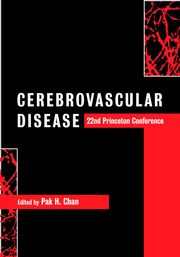Book contents
- Frontmatter
- Contents
- List of contributors
- Preface
- Acknowledgments
- Part I Special lectures
- Part II Oxidative stress
- Part III Apoptosis
- Part IV Hot topics
- Part V Hemorrhage, edema and secondary injury
- Part VI Inflammation
- Part VII Gene transfer and therapy
- Part VIII Neurogenesis and plasticity
- Part IX Magnetic resonance imaging in clinical stroke
- Part X Risk factors, clinical trials and new therapeutic horizons
- 32 Vascular factors in Alzheimer's disease
- 33 Beyond neuroprotection: the protection of axons and oligodendrocytes in cerebral ischemia
- 34 Combining neuroprotection with thrombolysis: how to translate laboratory success to our clinical trials
- 35 Prospects for improved neuroprotection trials in stroke
- 36 Basic research and stroke therapeutics: what have we learned?
- Index
- Plate section
35 - Prospects for improved neuroprotection trials in stroke
from Part X - Risk factors, clinical trials and new therapeutic horizons
Published online by Cambridge University Press: 02 November 2009
- Frontmatter
- Contents
- List of contributors
- Preface
- Acknowledgments
- Part I Special lectures
- Part II Oxidative stress
- Part III Apoptosis
- Part IV Hot topics
- Part V Hemorrhage, edema and secondary injury
- Part VI Inflammation
- Part VII Gene transfer and therapy
- Part VIII Neurogenesis and plasticity
- Part IX Magnetic resonance imaging in clinical stroke
- Part X Risk factors, clinical trials and new therapeutic horizons
- 32 Vascular factors in Alzheimer's disease
- 33 Beyond neuroprotection: the protection of axons and oligodendrocytes in cerebral ischemia
- 34 Combining neuroprotection with thrombolysis: how to translate laboratory success to our clinical trials
- 35 Prospects for improved neuroprotection trials in stroke
- 36 Basic research and stroke therapeutics: what have we learned?
- Index
- Plate section
Summary
Introduction
The experimental basis for neuroprotection is well founded. In a range of animal models of ischemic stroke, drugs acting by a variety of mechanisms can be administered up to several hours after the ischemic insult and reductions in infarct volume can be demonstrated. Whilst individual models have their proponents and their disadvantages, numerous strategies have been sufficiently convincing to encourage clinical development. Examples of drugs reaching large clinical trials range from free radical scavengers, γ-aminobutyric acid (GABA) agonists and calcium antagonists, through a range of drugs acting on the glutamate cascade to precursors of membrane constituents such as citicoline. Unfortunately, the range of drugs and mechanisms that has been tested in the clinic and has so far failed, exactly parallels the former list (Table 35.1). In most cases, the result has been neutral but a few drugs had adverse effects that were not anticipated from the preclinical studies.
In the face of these disappointments, some pessimism amongst the clinical researchers would be understandable, but instead a cautious optimism remains. This is based on sound scientific analysis of the progress that has been made and the prospects for adjusting the development strategy for future compounds.
Potential reasons for the failure of previous clinical trials have been widely reviewed. Most are speculative, but the principles that underlie them can readily be tested and bear repetition. First, the translation from animal models to human stroke demands certain assumptions.
- Type
- Chapter
- Information
- Cerebrovascular Disease22nd Princeton Conference, pp. 430 - 443Publisher: Cambridge University PressPrint publication year: 2002
- 2
- Cited by



